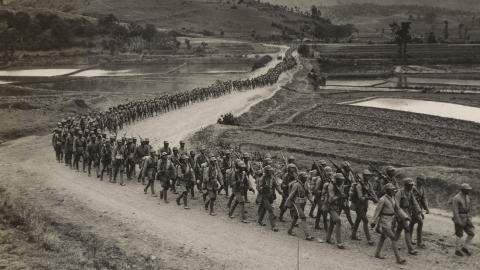WW2 British Command Centres
The brutal, horrific chaos of World War II cost the world almost 3% of its population. Exact figures are understandably hard to come by but most contemporary sources put the number of dead – military and civilian (including those dying from subsequent war-related disease and famine) – at between 70-85 million.
The world was in a state of total war involving over 100 million people from 30 or more countries and the biggest players committed their entire financial, industrial and scientific capabilities to the war effort. Entire nations were decimated and some were rendered bankrupt.
In the six years of the war, the German Nazi regime collapsed, the Italian and Japanese empires fell, we ushered in the Nuclear Age, the League of Nations died and the US and the Soviet Union walked headfirst into a decades-long Cold War.
But out of the darkness of destruction, death and devastating economic ruin came a permanently-changed geopolitical and cultural landscape. As the League of Nations died, the United Nations, established to foster international discourse and cooperation, rose phoenix-like from the flames. In the wake of the war, the influence the great powers exerted over much of the world started to wane and it triggered decolonisation of much of Asia and Africa.
The world moved slowly towards expansion and economic recovery (some more slowly than others) as well as political integration, especially in Europe.
But for all this to happen, a war had to be fought and while the men in the trenches, the tanks and the planes were doing the actual fighting and most of the time it seemed like complete and utter anarchy, it was all underpinned by strategy, organisation, planning, structure and leadership from the finest military and intelligence minds of their generations.
And it was all done from some entirely unlikely places…
RAF Bentley Priory
Bought by the Air Ministry for the princely sum of £25,000 in 1926, what came to be known as RAF Bentley Priory, a beautiful yet unassuming Grade II listed mansion in the leafy north-west London suburb of Stanmore, played a vital role in the Allied victory over Nazi Germany.
In the inter-war years as the RAF was developing, what was known as the Air Defence of Great Britain (ADGB) was stationed at Bentley Priory. After a few iterations, dissolutions and mergers, there emerged RAF Fighter Command on the 14th July 1936 under its first Commander-in-Chief, Air Chief Marshal Sir Hugh ‘Stuffy’ Dowding, the man credited in large part for the decisive Allied victory at the Battle of Britain.
From RAF Bentley Priory, Sir Hugh created what became known as the Dowding System, the world’s first wide-area ground-controlled interception network. The network of telephone landlines allowed for information to be called in and collated very quickly, subsequently allowing Fighter Command to build up a picture of the UK’s airspace. The combination of early detection and speed of dissemination meant that the fighter squadrons could be used at exceptionally high rates of effectiveness and this proved key to the Allied success at the Battle of Britain.
Beyond the importance of the Dowding System, ‘Stuffy’ and his officers meticulously prepared Britain’s air defences, marshalled resources including additional and replacement planes and aircrew and maintained a significant reserve, in turn allowing his subordinates to run the minutiae of the battles.
It’s fair to say that without Dowding’s strategic nous at RAF Bentley Priory, the Battle of Britain may not have ended as it did. Today, RAF Bentley Priory is a fascinating museum that tells the story of how the Battle of Britain was won.
Camp Griffiss
Named for Lieutenant Colonel Townsend E Griffiss, the first US airman killed in Europe following America’s entry into World War II, Camp Griffiss served as the Supreme Headquarters Allied Expeditionary Force, or SHAEF, from late 1943 until the end of the war.
Commanded by legendary General Dwight D Eisenhower who was understandably reluctant to be located in central London, it was built in the grounds of Bushey Park in Teddington, south-west London. However, it was commonly held that it was supposed to be built close to RAF Bentley Priory in the north-west London suburb of Bushey but ended up south of the river due to an error.
Regardless of where it was originally intended to be, Camp Griffiss was where Eisenhower and his cronies planned Operation Overlord, the successful invasion of German-occupied Western Europe that started on the 6th June 1944 with D-Day, otherwise known as the Normandy Landings or Operation Neptune.
Over 1,200 planes, 5,000 vessels and 160,000 troops crossed the Channel that day and over two million men were in France by the end of August, and it was all planned at Camp Griffiss.
Most of the buildings were dismantled by the early 1960s and today, there is a series of memorials dotted around the park including the site of General Eisenhower’s office, a plaque marking the corner of C-Block and if you’re into treasure hunting, there’s a small concrete obelisk left by the American forces stationed there inscribed 5 CD, TEXAS, 1942. Try and find it!
Cabinet War Rooms
Perhaps the most famous of all World War II command centres, the Cabinet War Rooms was the subterranean HQ from where Prime Minister Winston Churchill and his wartime government convened to direct the course of the war.
Such was the rush to get the underground bunker ready, it became fully operational just six days before Britain declared war on Germany on 3rd September 1939.
When Churchill arrived in 1940, he walked into the Cabinet Room and proclaimed ‘This is the room from which I will direct the war.’
Buried beneath the Treasury building on Whitehall, the two most important rooms in the complex (amongst the estimated 200 in total) were the Map Room - which remained permanently staffed by officers of the three branches of the armed services, the Royal Navy, the Army and the Royal Air Force - and the Cabinet Room.
When Churchill arrived in 1940, he walked into the Cabinet Room and proclaimed ‘This is the room from which I will direct the war.’ In total, 115 meetings of the wartime Cabinet were held there, the last one being on 28th March 1945 when the German ‘Vergeltungswaffen’ or V-weapon campaign ended and Hitler realised the end was nigh.
As the war ended with Japan’s surrender, the Cabinet War Rooms became redundant and were essentially abandoned until the 1980s when it’s administration was taken over by the Imperial War Museum. It was officially opened (or re-opened) by Prime Minister Margaret Thatcher on 4th April 1984.
Today, the Cabinet War Rooms is open for visitors (including, at one point or another, every child who attends school in London and the Home Counties) to explore the historic spaces that once fizzed with strategy, secrets and ultimately, success.
Brompton Road Tube Station
An unlikely contender in the category of Britain’s most important World War II command centres perhaps, but Brompton Road tube station has sat silently (to underground trains at least) between Knightsbridge and South Kensington on the Piccadilly Line for almost 85 years.
It was opened in December 1906 by the Great Northern, Piccadilly & Brompton Railway and although close to the Brompton Oratory and V&A Museum, it saw very little traffic. Within just three years, many services passed right through and it closed for good in July 1934.
It was from the bowels of Brompton Road tube station that the gun emplacements positioned around the capital were coordinated.
Just before the outbreak of World War II, the building, including the lift shafts and lower western passages, was sold to the War Office for £22,000 for use by the British Army’s Air Defence Formation, The 1st Anti-Aircraft Division. As part of the conversion from tube station to command bunker, the platforms were lowered and walls were built along their lengths to protect the servicemen and women from the Piccadilly Line trains running past between Knightsbridge and South Kensington. Toilets and basic amenities were installed in the passages, as were air filtration units and pressurised doors to protect the occupants from gas attacks.
It was from the bowels of Brompton Road tube station that the gun emplacements positioned around the capital were coordinated. All the information that came in from the radar stations, Royal Observer Corp Group HQ and other services plotted on the RAF Group Operations table was copied to Anti-Aircraft HQ. Guns were not permitted to engage without permission from the RAF Group Commander and the Anti-Aircraft HQ was in direct telephone contact with all gun sites.
AA HQ stayed in Brompton Road until the 1950s however little remains of the war effort aside from a single map on one of the walls.
Unfortunately, it’s not accessible to the public (and the site was sold in 2014 for £53m to a businessmen who intended to convert it to residential use but as yet remains unused) but even though it’s a long-forgotten legacy of the war, it cements its place as a protector of London and as such, one of our most important command centres.
Bletchley Park
The mansion near Milton Keynes in Buckinghamshire built for financier Sir Herbert Leon and family in the mid-1880s was Britain’s most closely-guarded secret but one of the most vital centres of intelligence operations during World War II.
In fact, the official historian of British Intelligence said that the ultra-intelligence produced at Bletchley shortened the war by between two and four years and without it, the outcome of the war would have looked decidedly uncertain, right up to the very end.
The mansion, built in a mixture of Victorian Gothic, Tudor and Dutch Baroque styles, was sold to a property developer in 1938 but very quickly resold to the Head of the Secret Intelligence Service, (SIS, or as we know it today, MI6) Admiral Sir Hugh Sinclair for £6,000 of his own money after the Government claimed they hadn’t the money to fund a centre for intelligence operations.
Geographically perfect (adjacent to Bletchley station where trains ran frequently between Oxford and Cambridge from where Station X as it became known recruited many of the codebreakers) and with excellent links around the country, the Government Code & Cypher School moved in.
Such was the importance of the work done by people like Alan Turing, Gordon Welchman, Hugh Alexander and Stuart Milner-Barry and countless thousand other men and women that in a letter to Churchill by some of the senior codebreakers decrying the lack of resources, the Prime Minister sent a note to his military advisor General Hastings ‘Pug’ Ismay simply saying ‘Make sure they have all they want extreme priority and report to me that this has been done.’
Some of Britain’s finest mathematicians worked around the clock at Bletchley Park penetrating the communications of the Axis Powers, work culminating in the cracking of the Enigma and Lorenz cyphers and onto the development of Colossus, the world’s first programmable computer and the Bombe, a spectacularly complex electromechanical device designed to discover and decode the daily settings of the Enigma machines within the German military network.
So secret was the work undertaken there that information about what went on was classified under the Official Secrets Act until as recently as the mid-1970s (even from people in the same family) but today, Bletchley Park is a wonderful heritage museum. Visitors can explore its history, see the huts Turing et al worked from and even take afternoon tea in the mansion!
















